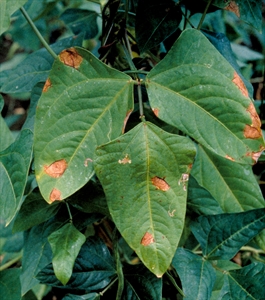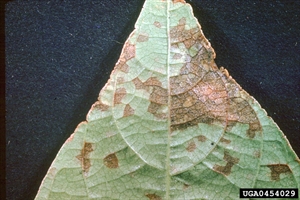Angular bean leaf spot
Pacific Pests, Pathogens, Weeds & Pesticides - Online edition
Pacific Pests, Pathogens, Weeds & Pesticides
Bean angular leaf spot (216)
Pseudocercospora griseola; previously known as Phaeoisariopsis griseola and Isariopsis griseola. Several strains of the fungus are known.
Asia, Africa, North, South and Central America, the Caribbean, Europe, Oceania. It is recorded from Australia, Fiji, New Caledonia. New Zealand, Papua New Guinea, Solomon Islands, and Vanuatu.
Phaseolus vulgaris (common bean, field bean, French bean, kidney bean, string bean), cowpea, soybean. Other hosts include Desmodium species and Dolichos lablab.
Spots are usually seen first at flowering. Two types of symptoms occur depending on the leaf type. On the trifoliate (3 leaflets) leaves, angular spots up to 3 mm wide, grey and then light brown, sometimes surrounded by a yellow halo, but limited by the veins (Photos 1&2). On the primary (single) leaves, the spots are up to 15 mm diameter and are often with rings, like a target. Fungal mould grows on the undersides of both types of spot, and produces the spores.
On the pods and stems, dark, sunken, oval to circular spots of varying size occur (Photo 2). The spots may join together. Seed becomes infected beneath the spots on the pods. They become discoloured.
Spread is by airborne spores released from the spots on the leaves. Spread over long distances occurs on seed. The fungus is splashed in rain from the infected seed to the leaves.
The fungus survives between plantings in the remains of the crop, on 'volunteer' plants, and on seed, where it can survive for at least 12 months. The disease is favoured by moderate temperatures (16-28°C), rain or high humidity, alternating with dry times. The wet periods allow spore germination, infection and production on the spots; dry periods allow spread of the spores in the wind.
An important disease in sub-tropical and tropical countries. The spots may be so numerous as to cause premature leaf fall, and the spots on the pods lower quality. It is a particularly important disease in some African countries where legumes are a major source of protein. Losses of 50% of the crop were reported during epidemics in countries of Africa and South America, and occasionally in the USA.
Look for the two types of leaf spots, those on the leaves with three leaflets that are angular and limited by the veins, and those that are larger and somewhat circular on the singles leaves. Look for the reddish-brown round spots on the pods with dark borders.
CULTURAL CONTROL
Before planting:
- Make sure that the seed is certified free of the fungus.
After harvest:
- Collect and burn or bury as much of the crop as possible after harvest.
- Do not plant one crop of bean after another in the same land; use a rotation of at least 2-years.
RESISTANT VARIETIES
There are resistant bean and cowpea resistant varieties. However, in some varieties resistance to spots on the leaves and spots on the fruit may differ.
CHEMICAL CONTROL
Treat seed with carbendazim. If fungicides are needed for control of leaf or pod spots, use a copper product or mancozeb.
____________________
When using a pesticide, always wear protective clothing and follow the instructions on the product label, such as dosage, timing of application, and pre-harvest interval. Recommendations will vary with the crop and system of cultivation. Expert advice on the most appropriate pesticides to use should always be sought from local agricultural authorities.
AUTHOR Grahame Jackson
Information from (including Photo 3) Diseases of vegetable crops in Australia (2010). Editors, Denis Persley, et al. CSIRO Publishing; and McKenzie E (2013) Phaeoisariopsis griseola: PaDIL - http://www.padil.gov.au; and Phaeoisariopsis griseola (PHAIGR) (undated) EPPO Global Database. (https://gd.eppo.int/taxon/PHAIGR); and from CABI (2019) Crop Protection Compendium. (https://www.cabi.org/cpc/datasheet/40010). Photo 1 Kohler F, et al. (1997) Diseases of cultivated crops in Pacific Island countries. South Pacific Commission. Pirie Printers Pty Limited, Canberra, Australia. Photo 2 R. Lafon, INRA, Bordeaux, Bugwood.org.
Produced with support from the Australian Centre for International Agricultural Research under project PC/2010/090: Strengthening integrated crop management research in the Pacific Islands in support of sustainable intensification of high-value crop production, implemented by the University of Queensland and the Secretariat of the Pacific Community.






